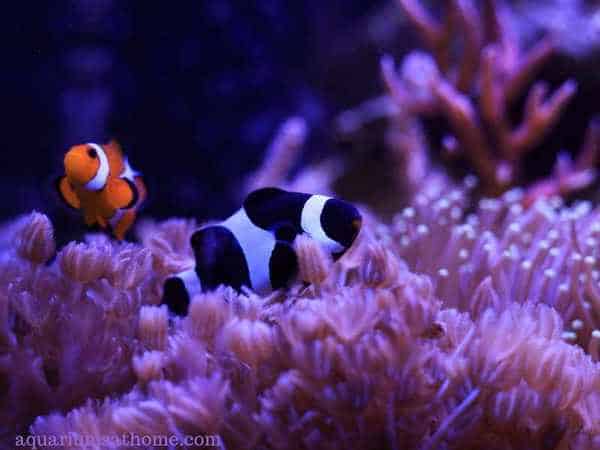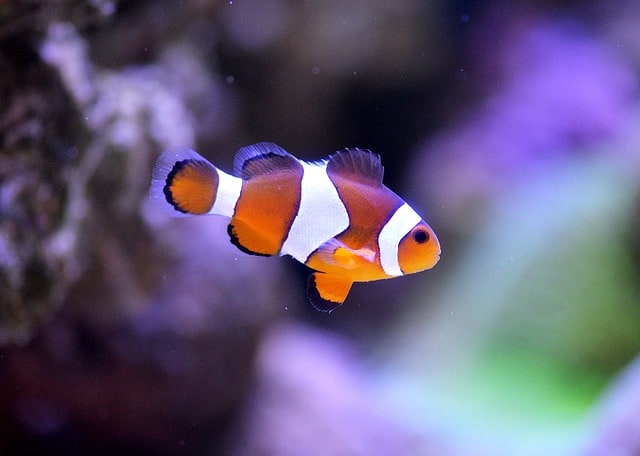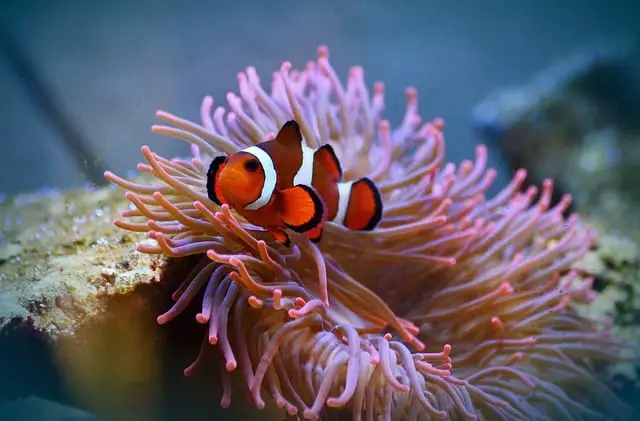When you think of clownfish, the image that often comes to mind is that of the gentle Nemo from the Disney/Pixar animated classic ‘Finding Nemo.’ Clownfish in real life, however, aren’t typically so timid and will even fight to the death! The question remains, ‘how can you tell if your clownfish are fighting?’
The telltale sign that two female clownfish are fighting is when they lock mouths. A mated pair will also fight when the female is trying to assert her dominance over the male. The aggressive behavior usually begins with the female relentlessly chasing the male about and even nipping at his fins.
Now that you know locking of mouths, chasing after each other, and nipping at fins are all signs of clownfish aggression, let’s explore this topic together in more detail. We’ll learn why clownfish fight one another and what to do to stop/prevent it. We’ll also learn how food, tankmates, and aquarium size also affect clownfish temperament and why territoriality is typically the culprit.
So, if you’re ready to learn more about clownfish hostility and how to limit this behavior in captivity, then let’s begin!
Is it Normal for Clownfish to Fight Each Other?
It’s very common for clownfish to fight and demonstrate hostility towards one another, especially in captivity where space is limited. Their innate need to defend their territory and/or anemone against any-and-all invaders is the leading cause of this aggression.
Why do Clownfish Fight?
Clownfish will often fight to defend their territory and/or anemone from invading fish. They’ll also fight to protect their eggs from potential predators. Typical aggressive behavior usual includes chasing other fish relentlessly and nipping at their fins.
Clownfish will also become aggressive when engaging in mating rituals. Males will chase the females and towards the nests he’s prepared to initiate spawning. If there’s more than one male in a tank, the two may chase each other about and nip at each other’s fins until the larger of the two switches gender.
Multiple females in a tank will also fight each other for dominance. They typically lock mouths and won’t submit until one is dead! The survivor becomes the dominant female and earns the right to breed with the lone male. The two then become a mated pair and will spawn only with each other from then on.

How Long will Clownfish Fight for?
Clownfish males and females will fight frequently in captivity, even after becoming mated pairs. After about 6 months or so, you should start to see them calming down with one another. Their aggression towards others of their kind is one of the main reasons why you can’t keep them in groups in captivity.
Will Clownfish Fight to the Death?
Female clownfish will fight to the death, especially when kept in groups in a confined space like an aquarium. There can only be one dominant female to pair up and mate with the male. Since all clownfish are born male, if you have two males in a tank, the larger one will switch gender to female.
Do Female Clownfish Fight?
Contrary to most saltwater fish whereby the males fight each other for dominance, female clowns are the aggressors for their species. Two females will lock mouths and battle to the death for the right to pair up and mate with the male.
Do Male Clownfish Fight?
Male clownfish will fight one another for territory when in captivity. Typically, however, if there are only males in an aquarium, the largest will switch gender to female. This female then becomes the dominant fish and will pair up with a male to procreate.
Will a Mated Pair of Clownfish Fight?
A mated pair of clownfish will engage in aggressive behavior when it’s time to spawn. The male will chase after the female and try to coax her to the nest he’s made. She, in turn, may try to assert her dominance over him by chasing after him and even nipping at his fins.
What to do if Clownfish are Fighting?
It’s common behavior for clownfish in captivity to act aggressively towards one another. That said, there are things you can do as an aquarist to prevent and/or stop this hostility before it becomes problematic. These include the following:
Maintain Stable Water Conditions
Since clownfish aggression is associated with stress, maintaining stable and accurate water parameters is a must! The aquarium must have a heater, filter, and light. The temperature in the tank should be between 76-and 82-degrees F with a pH level of 7.8 to 8.4 and a specific gravity around 1.021 to 1.026.
Ensure the Tank is Large Enough
Clownfish will become hostile in a tank that’s too small or overcrowded. They’ll fight for territory if space is limited. Each clownfish needs at least 10-gallons of water so for a mated pair (which is how they should be kept in captivity), you need at a 20-gallon aquarium minimum.
Keep the Tank Clean
Making sure the aquatic environment is clean and toxin-free will help reduce clownfish aggressions. A ‘dirty’ tank causes illness and stress for fish. When sick or anxious, they’ll become more hostile. If the tank is well-established, doing partial (15% to 25%) water changes once a month is recommended.
Provide Plenty of Hiding Places
Since clownfish typically fight over territory, providing plenty of hiding places and/or areas for fish to claim as their own will help limit aggressive tendencies. Adding anemones to the tank is essential for keeping clownfish calm and peaceful.
Feed Adequately and Appropriately
Since clownfish will fight anything that invades their space, spreading out food during feeding times is essential. This prevents fish from having to enter another’s area to eat. As well, ensuring fish are feed enough will also reduce aggression – twice a day with whatever can be eaten in a 2-minute time-period.
Keep Clownfish in Mated Pairs
Clownfish should be kept either alone or in a mated pair. They aren’t tolerant of others of their kind and will become aggressive if kept in a group. The only way you can keep more than 2 is in a very large tank with plenty of coverage. That said, don’t mix different species of clownfish, no matter how big the tank.
Keep Clownfish with Suitable Tankmates
Clownfish will become hostile towards smaller tankmates. They’ll bully timid fish by chasing after them and nipping at their fins. Therefore, they must be kept with fish of like size and temperament. As well, since clownfish like to swim in the middle of the tank, keeping them with bottom-dwellers is suggested.
Isolate the Aggressor
When all else fails, try isolating a hostile clownfish. Place it in a quarantine tank or a net breeder for a few days to see if this reduces its aggression. Should you place it back in the main aquarium and it’s still hostile, you may need to consider rehoming it permanently.

Do Tankmates Contribute to Clownfish Aggression?
Tankmates are a big factor in clownfish aggression. If they’re kept with fish that’re also aggressive and territorial, they’ll likely get into fights! Never place clownfish in the same tank as groupers or lionfish. As well, don’t house them with smaller, weaker fish like royal grammas as the clownfish will harass them.
Choosing appropriate tankmates for clownfish is dependent on the size and species. Look for fish of similar size that aren’t too hostile or too timid. Some examples of fish that can cohabitate peacefully with clownfish in captivity include dartfish, damsels, tangs, blennies, puffers, gobies, and anemones.
Final Thoughts
To summarize, you can tell two female clownfish are fighting when they lock mouths. A mated pair, on the other hand, will also fight when the female is trying to assert dominance over the male. You’ll notice her chasing after him and even nipping at his fins. Territoriality is typically at the root of their aggression.
I hope this article has answered your questions regarding clownfish hostility in captivity. Thanks for reading and good luck with your aquarist hobby.
Recommended Posts
Clarkii Clownfish Care Guide and Tank Setup (Behavior, Breeding, Tank Mates, etc.)
Clown Fish Tank Set Up for Beginners
Can You Have 3 Clownfish in a Tank?






